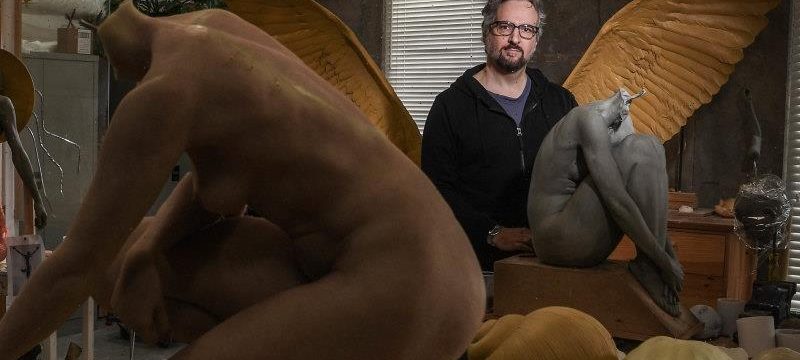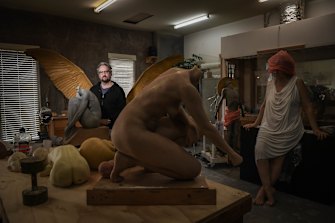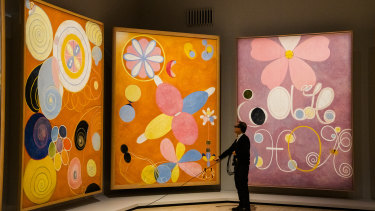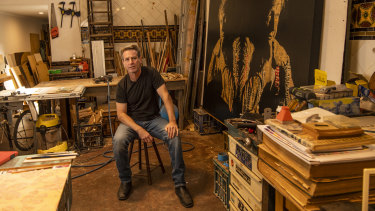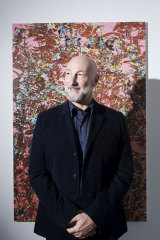Sam Jinks makes hyperreal sculptures of the human form, so anatomically correct it’s like peering into a mirror.
Each work takes months to complete: from the first sketch to clay model, from resolved maquette to hand-painted resin mold.
Sam Jinks’ hyperreal sculptures take months to complete.Credit:Justin McManus
This month’s self-titled solo exhibition at the Sullivan + Stumpf gallery was to have been Jinks’ first in Australia in seven years, consolidating his many international successes on home soil.
But last week he made the painful decision to delay the show’s August 12 opening until 2022, making him just one of many artists forced to shift shows online or indefinitely postpone creative projects long in the gestation. For Jinks it was the sixth solo or group show in 18 months that had fallen foul of lockdowns.
“When I suspected lockdown was going to happen I made a decision to keep my powder dry so to speak,” he says from his Melbourne studio just days out of lockdown. “Everything was connected to one central work that was very atmospheric and while there are some images of elements online that wasn’t the experience I wanted people to have.”
COVID-led public health restrictions around the world have shuttered public and private galleries, disrupting the established model by which artists bring work to public attention and forcing galleries to connect exclusively with audiences and collectors in the virtual world.
The Art Gallery of NSW’s popular Hilma af Klint show has gone online.Credit:James Brickwood
The Art Gallery of NSW has led the way, converting casual online visitors with its wry social media posts and online walkthrough of the works of Hilma af Klint.
Commercial galleries are also using every online tool at their disposal to engage viewers. Nanda\Hobbs Gallery at Chippendale has been running Zoom seminars, streaming how-to video content, and running virtual exhibition tours and talks with exhibiting artists.
Only a fortunate few saw Paul Ryan’s new show South by Southwest in the flesh at the Nanda\Hobbs gallery before it shut its doors and went online.
Nanda\Hobbs kept Les Rice’s show up but the bespoke wallpaper of colonial motifs, the physical backdrop for Ryan’s show in its main gallery, was removed to make way for Laura Matthews.
The gallery is planning a Greatest hits of Lockdown show when Sydney reopens.
James Powditch’s latest exhibition has been pushed back until September.Credit:Louise Kennerley
For those people who find entering a gallery intimidating, digital viewing rooms can be places of non-judgmental escape and inspiration. They have become a platform for regional and remote artists, First Nations artists and artists with a disability.
Collectors, too, have adapted well to researching and buying art online, says Nanda\Hobbs marketing manager Sophie Hobbs. She points to Australian art auction totals from January to July this year that were almost $20 million higher than the same period last year – a result of phone bidding and internet sales that have markedly increased since COVID hit.
“For any artist, it’s certainly disappointing not to celebrate the many months of work that have gone into building an exhibition – seeing their work on the gallery walls and getting feedback and acknowledgment at openings and viewings,” Hobbs says.
“But from a sales point of view, little has changed. For a number of years, we’ve had a strong online presence. In fact, over 80 per cent of sales are done online, without physically seeing the artwork.”
Sullivan + Strumpf had their best sales year ever amid the COVID disruptions in 2020. Ceramicists Glenn Barkley and Ramesh Mario Nithiyendran sold out their shows when they went online last year, both artists benefiting from an outpouring of what gallerist Ursula Sullivan describes as “philanthropic heart”.
“Australians really wanted to put their money where their heart was,” she says.
Sullivan has detected some digital fatigue this time around but “people are still actively collecting and I think people who love art really miss that engagement and are looking for it”.
Sydney Contemporary Fair director Barry Keldoulis.Credit:Christopher Pearce
The experience of lesser-known artists and smaller galleries has been less spectacular, according to Sydney Contemporary Fair director, Barry Keldoulis.
Cancelled last year, the SCF has been rescheduled to November. An important cog in the ecology of the national visual arts sector, the fair connects fans and buyers to galleries and artists in the less intimidating atmosphere of what resembles a trade show, generating the most concentrated week of art sales – $15 million in 2019 of which $10 million was returned to artists – in the Australian calendar year.
“A healthy number of galleries had one of their best years ever last year, and a lot said they did well, a few kept steady and a healthy per cent had a drop in sales sufficient to earn JobKeeper – and that would have been, maybe, half of all galleries,” Keldoulis says.
A gallery show is the culmination of long hours spent by the artist in the singular and solitary pursuit of creativity. The sales that come from it sustain artistic practice into the future and underpin future works. Artist talks and workshops are a secondary source of income for presenting artists.
The intangibles also greatly matter, namely the exposure and press. Waymarkers in the development of an artist’s career; the solo exhibition acknowledges and validates an artist’s place.
The disruptions risked “affecting artist careers for a number of years before they can recover their momentum”, says Mimi Crowe, advocacy director of the National Association for Visual Arts.
At Nanda\Hobbs James Powditch’s The Proposition, featuring mixed media works inspired by classic Australian films, has been pushed back to September. Powditch, a multiple Archibald Prize finalist, has a lot personally riding on this show.
“From my perspective, this show is important to get back in the game,” Powditch says referring to his three-year absence from the gallery circuit and his chance to cement his new relationship with Nanda\Hobbs. “It’s make or break for me. A year’s worth of income is dependent on those one or two weeks.”
Powditch speaks for many artists when he says he is finding this year’s rolling lockdowns more difficult to cope with than before. It’s never been tougher for artists, with bills to pay and many ineligible for lockdown grants.
The state’s visual artists are well down the list for extra funding, with governments assuming that these creatives can easily hibernate and wait out the crisis. NAVA’s artist benevolent fund, which provides emergency relief, is exhausted. Crowe says it’s hard for artists to demonstrate lost income because of the nature of artmaking.
“NAVA would like to see greater support from the federal government disaster funding in the same way as the music industry received through Support Act as well as some new funding to make new work,” Crowe says.
Cancellations have come for Jinks and other artists in the second year of a traditional two-year cycle that turns on a 12-month intensive period of making new work and culminates with shows and sales.
Gallery directors speak of working doubly hard for their stable of artists, a large part of their responsibility now to check in regularly on their mental health.
Life is particularly precarious for the unrepresented artist or the student out of art-school. Nanda\Hobbs has taken on Jody Graham after seeing their work develop online. In the main, however, collectors won’t buy from an unknown artist sight unseen, says Keldoulis.
Director of COMA in Darlinghurst Sotiris Sotiriou believes lockdowns are accentuating a trend towards digital platforms that were happening well before COVID-19 entered the lexicon. Buyers, collectors, and artists needed to adjust to the new environment.
COMA represents a new generation of cutting-edge artists including Jack Lanagan Dunbar, JD Reforma, Zara June Williams and the work of new faces from overseas whose work must stand for itself.
“Even before COVID, we asked our artists for a lot of resources to share,” Sotiriou says.
Until recently COMA in Darlinghurst had been taking appointments for contactless walk-throughs, replacing them during harder lockdown conditions with Zoom and Facebook tours of Nick Modrzewski’s The Plaintiff’s New Face.
An emerging Australian artist working primarily in painting and sculpture, Modrzewski’s theatrical perspective on law has sold well but not yet sold out as it might have done had the gallery not shut its doors to the public.
Buyers have been overwhelmingly in-the-know collectors and fellow museum and gallery directors. Sotiriou is confident that once lockdown ends red stickers will go up on all works.
“We try and prep our artists not to be too antsy if they miss a show and are not able to see it in final form on white walls,” he says.
“In recent times hundreds of artists all over the world have missed shows. If you miss a show that hurts, but you just have to suck it up. There is a lot of babying of artists at this time. They are great at making work, they are great at making their work understood, and there will always be a place for it.”
For Michael Lindeman’s Art Habits Sullivan + Strumpf commissioned text by the celebrated writer Martha Farquhar, and a video walkthrough. Lindeman personally funded an audio tour by Matthew Tumbers and posted out handwritten postcards to generate buzz.
“My loss is the viewers’ gain,” says Lindeman. “I’ve never seen a more comprehensive and entertaining online exhibition experience.”
Still, he misses the face-to-face interaction. “For me, art is an emotional and visceral experience but equally, a cerebral invitation to the viewer,” Lindeman says.
“I think a digital exhibition has its place as an auxiliary part but not a stand-in. When developing a show I always consider how certain works bounce off each other and steer the audience around the space, something that can’t be curated as tightly in the digital realm.”
Crowe worries that the disruptions of the past two years might turn into a “multi-year problem and a decade-long problem” as major galleries and museums plan cautiously.
The upside of the latest lockdown for Jinks is he will have more time to make additional work for the delayed exhibition. “The future is always uncertain but at the moment it feels reliably unreliable,” he said.
Find out the next TV, streaming series and movies to add to your must-sees. Get The Watchlist delivered every Thursday.
Most Viewed in Culture
From our partners
Source: Read Full Article
